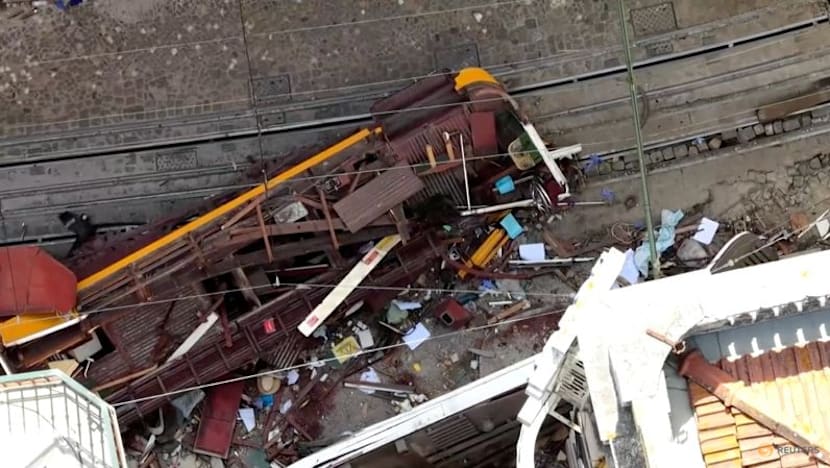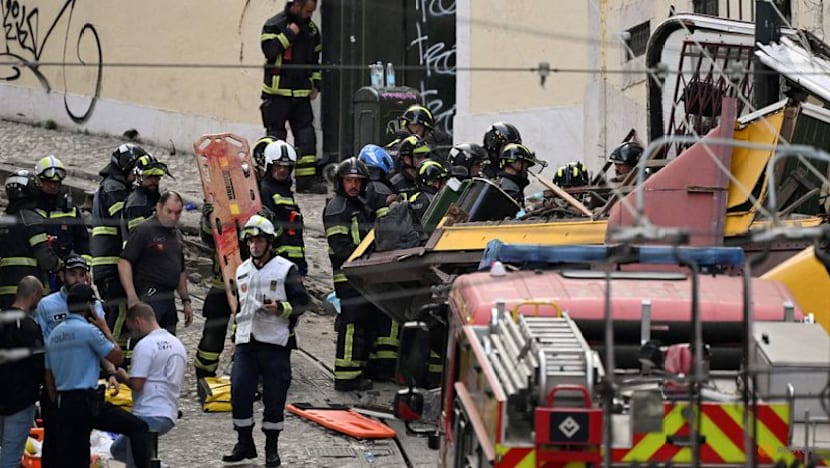Portugal investigates crash on historic Lisbon funicular

Lisbon's Gloria funicular railway car derailed and crashed, resulting in multiple casualties, on Sep 3, 2025. (Photo: Reuters/Pedro Nunes)
LISBON: Portuguese authorities were investigating on Thursday (Sep 4) what caused a Lisbon funicular railway popular with tourists to hurtle down a hill, killing at least 16 people and injuring 22 more when it crashed into a building on Wednesday.
The Prosecutor General's office said coroners had so far identified the bodies of five Portuguese, two South Koreans and one Swiss national, without disclosing further details of those killed.
A US citizen was killed in the crash, the State Department said in a statement. According Portugal's judicial police chief, Luis Neves, there was a "high degree of certainty" that there were also two Canadians, one Ukrainian and one German among the dead, although the identities could not yet be officially confirmed.
The mangled wreckage of a yellow tram-like carriage, which carries people up and down a steep hillside in the Portuguese capital, lay where it had left the track and hit a building on Wednesday, just metres from its twin at the bottom of the steep 265-metre slope. The traction cable linking them had snapped.
Lisbon resident Abel Esteves, 75, and his wife and grandson were among 40 passengers in the lower car who saw the carriage plunge toward them before derailing at the last second.
"I told my wife: 'We're all going to die here'," he said. "It picked up a brutal speed, took a slight turn and hit the building with a loud bang."

CABLE PROBLEMS REPORTED ON FUNICULAR
Manuel Leal, leader of the Fectrans union, told local TV that workers had complained that problems with the tension of the cable that hauls the carriages had made braking difficult, but that it was too early to say if that was the cause of the crash.
The municipal transport company Carris said in a statement that "all maintenance protocols have been carried out", including monthly and weekly maintenance and daily inspections.
"On Wednesday morning, the inspection was carried out and no faults were detected. ... We cannot assume that the problem was with the cable. The investigation will determine the cause," Carris CEO Pedro Bogas told reporters.
He said the maintenance of the funicular had been outsourced since 2007 and had been performed by accredited and specialised technicians.
The two cars, each capable of carrying around 40 people, alternately climb the slope and descend as electric motors pull the cable linking them.
That cable appears to have snapped, a fire brigade official said. Seemingly unable to check its descent, the carriage entered the turn too fast, ploughing into the cobblestone pavement and crashing into a building.
The lower car jolted back a couple of metres (yards) and was apparently undamaged, but video from bystanders showed several passengers jumping out of its windows.
The line, which opened in 1885, connects Lisbon's downtown area near the Restauradores Square with the Bairro Alto, or Upper Quarter, famous for its nightlife, and transports around 3 million people a year.
Portugal, and Lisbon in particular, has experienced a tourism boom in the past decade, with visitors cramming the popular downtown area in the summer months.

DAY OF MOURNING
Flags flew at half-staff and people left flowers at the site of the crash as Portugal declared a day of mourning. The Pope sent condolences and blessings to victims, relatives and rescuers.
"This is one of the greatest human tragedies in our recent history," Prime Minister Luis Montenegro said in a televised statement, adding that he expects the investigation into the causes of the accident to be concluded swiftly.
He said Portugal state airline TAP had offered to provide transport for the families of the victims and to repatriate the injured and the deceased.
Thirty-eight people were hurt in the accident, with 15 killed at the scene, while one more died in hospital overnight.
Among the injured were four Portuguese, two Germans, two Spaniards, one Korean, one Cape Verdean, one Canadian, one Italian, one French citizen, one Swiss and one Moroccan, said Margarida Martins, Lisbon's director of emergency services.
Local media reported that a German family of three had been among the victims. The father died in the crash while the mother was seriously hurt and their 3-year-old child suffered minor injuries, they said.
Eliane Chaves, a Brazilian who has lived in Lisbon for 20 years, said she walked past the Ascensor da Glória - one of the symbols of the city - every day.
"People say that it was negligence but it was not negligence," she said, tears streaming down her cheeks. "They supervise it thoroughly. It was an accident, just like a plane or car accident can happen."












